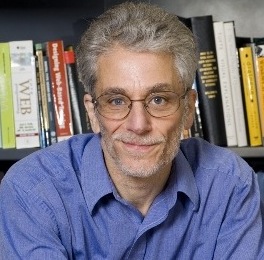
School of Informatics and
Research Technologies
Indiana University •
Bloomington, IN 47405
Offices:
School of Informatics, Informatics Building 307
Voice: +1 812-856-0129; Fax: -856-4764
Cook Music Library, Simon Hall M060B
Voice: +1 812-856-0129; Fax: -855-3843
E-mail: donbyrd(at)indiana.edu
Academia. I'm a Visiting Scientist in Research Technologies and, as Adjunct Associate Professor of Informatics, a member of the Music Informatics Group at Indiana University Bloomington. I've pushed some ideas for a "universal" visualizer for music to something much more general, and my informatics work now focuses on a framework for timeline-based interactive visualization, editing, and exploration of all time-based phenomena with, I believe, unprecedented flexibility -- what I call the "General Temporal Toolkit and Workbench" ("GTT/W"): here is a two-page summary, with links to more information. I've also continued to work on representation of music in symbolic form (broadly speaking, "music notation"). My research interests also include symbolic music information retrieval (music IR), digital libraries, user interfaces in general, and music and digital audio applications. Here is a short biography and a list of my publications. (Music has specialized requirements for references; I generally use my own reference style for music.)
Math education and other teaching. I have an additional strong interest -- more practical than research -- in mathematics education, especially at the high-school level, and I wear a corresponding "hat" as a Woodrow Wilson Indiana Teaching Fellow. For years I've been appalled at the way math is generally taught in U.S. primary and secondary schools, and especially since, in our technically-oriented society, it's vitally important for citizens to be mathematically literate. So, with a fellowship from the Woodrow Wilson National Fellowship Foundation, I earned a degree in math education; became a licensed secondary math teacher; and taught middle-school, high-school, and introductory college math from 2010 through 2012. I now try to support improve math education by writing a math-education blog, What I Learned about Why My Students Didn't Learn More, addressed primarily to secondary-school teachers, and by tutoring. I've also been creating and collecting Math Education Documents and Tools, and I'm pursuing several ideas for software to aid in teaching STEM disciplines. The GTT/W, mentioned above, is one very good possibility.
At a "higher" (in some sense) level, I formerly taught two graduate seminars, Introduction to Music Informatics and Music Information Representation, Search, and Retrieval, in the School of Informatics (but both cross-listed as music-theory courses). In early 2003, I taught a course similar to the latter in the School of Music; to my knowledge, that was the first course on music IR offered anywhere. See my Music Informatics Teaching Page.
Music notation, especially but not solely Conventional Western Music Notation, is something I've spent a great deal of time thinking about and working with over the last 35 years. My dissertation, Music Notation by Computer, is available online in scanned page-image form, or see my publication list for information on obtaining a bound copy. I created the musical examples for Hofstadter's Pulitzer Prize-winning book Goedel, Escher, Bach with my early music-printing program SMUT, and I was the principal designer and lead programmer for the commercial music-score editor Nightingale. The limits of conventional Western notation are fascinating and sometimes revealing. Have you ever wondered what the highest, lowest, shortest, or longest note ever written is? Or what the densest chord, or the shortest or longest piece is? I have; in fact, I've been working for many years on a list of Extremes of Conventional Music Notation. Drawing on that list and a collection of rule-breaking notation in my dissertation, here is a small Gallery of Interesting Music Notation.
Speaking of music notation, Optical Music Recognition (OMR) is a technology that has great potential but that hasn't gotten much attention so far. To help out, I've created a table of OMR systems, and I've done some research, sponsored by the Andrew W. Mellon Foundation, on the accuracy of current systems and how they might be improved.
It is rarely noticed that music IR covers a wide spectrum of problems, some far more difficult and/or ill-defined than others. My Similarity Scale for Content-Based Music IR attempts to clarify matters. I also maintain a music-IR, informatics, and visualization bibliography focused on my own interests. I've written a "white paper" on Musical Themes and Occurrences of Melodic Confounds that gives statistics on occurrences of some common features that make even searching for simple melodies or fragments of them difficult, especially with music in symbolic form.
Evaluation of music-IR other music-informatics systems is still in an early stage; one reason it hasn't advanced more is clearly a lack of test databases or collections available to researchers. To help things along, I try to maintain a list of Candidate Music IR Test Collections. In some ways, the situation has improved substantially in the last few years, and my list may not be as useful as it once was, but the situation is complex. In particular, MIREX makes several large test collections available to researchers, but they can be accessed only through the programming systems MIREX uses, and they're heavily slanted towards audio and away from music in symbolic forms.
Grants and conferences. I was Principal Investigator of a grant from the NSF-led International Digital Libraries initiative for Online Music Retrieval and Searching: this project was joint work with Tim Crawford and others at Kings College London and the University of Massachusetts. I was also General Chair of the NSF-sponsored International Symposium on Music Information Retrieval (ISMIR) held in Massachusetts in 2000. This highly-successful meeting was the first ever to focus specifically on music information retrieval; it led to an annual series of meetings; the Fourteenth ISMIR will be held in Brazil this fall. I was Co-PI, with Tim Crawford and Geraint Wiggins, of the MeTAMuSE (Methodologies and Technologies for Advanced Musical Score Encoding) project, funded by the Mellon Foundation, and I've completed two small grants for the GTT/W (see above).
Last modified: 13 June 2013
Comments to: donbyrd(at)indiana.edu